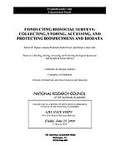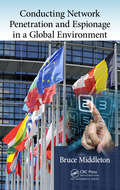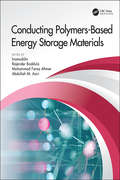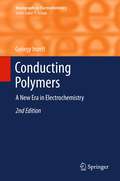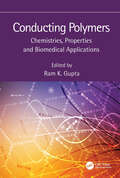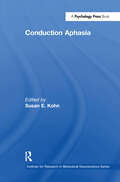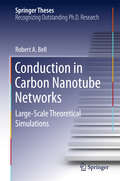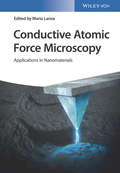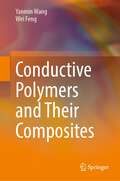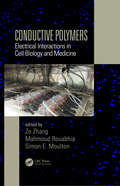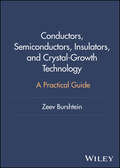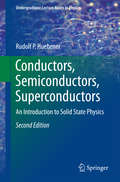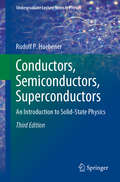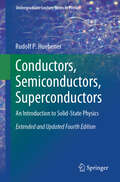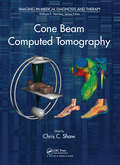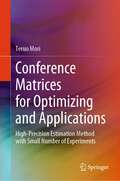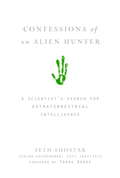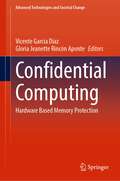- Table View
- List View
Conducting Biosocial Surveys: Collecting, Storing, Accessing, and Protecting Biospecimens and Biodata
by National Research Council of the National AcademiesRecent years have seen a growing tendency for social scientists to collect biological specimens such as blood, urine, and saliva as part of large-scale household surveys. By combining biological and social data, scientists are opening up new fields of inquiry and are able for the first time to address many new questions and connections. But including biospecimens in social surveys also adds a great deal of complexity and cost to the investigator's task. Along with the usual concerns about informed consent, privacy issues, and the best ways to collect, store, and share data, researchers now face a variety of issues that are much less familiar or that appear in a new light. In particular, collecting and storing human biological materials for use in social science research raises additional legal, ethical, and social issues, as well as practical issues related to the storage, retrieval, and sharing of data. For example, acquiring biological data and linking them to social science databases requires a more complex informed consent process, the development of a biorepository, the establishment of data sharing policies, and the creation of a process for deciding how the data are going to be shared and used for secondary analysis--all of which add cost to a survey and require additional time and attention from the investigators. These issues also are likely to be unfamiliar to social scientists who have not worked with biological specimens in the past. Adding to the attraction of collecting biospecimens but also to the complexity of sharing and protecting the data is the fact that this is an era of incredibly rapid gains in our understanding of complex biological and physiological phenomena. Thus the tradeoffs between the risks and opportunities of expanding access to research data are constantly changing. Conducting Biosocial Surveys offers findings and recommendations concerning the best approaches to the collection, storage, use, and sharing of biospecimens gathered in social science surveys and the digital representations of biological data derived therefrom. It is aimed at researchers interested in carrying out such surveys, their institutions, and their funding agencies.
Conducting Network Penetration and Espionage in a Global Environment
by Bruce MiddletonWhen it's all said and done, penetration testing remains the most effective way to identify security vulnerabilities in computer networks. Conducting Network Penetration and Espionage in a Global Environment provides detailed guidance on how to perform effective penetration testing of computer networks-using free, open source, and commercially avai
Conducting Polymers-Based Energy Storage Materials
by Inamuddin Abdullah Mohamed Asiri Rajender Boddula Mohammad Faraz AhmerConducting polymers are organic polymers which contain conjugation along the polymer backbone that conduct electricity. Conducting polymers are promising materials for energy storage applications because of their fast charge–discharge kinetics, high charge density, fast redox reaction, low-cost, ease of synthesis, tunable morphology, high power capability and excellent intrinsic conductivity compared with inorganic-based materials. Conducting Polymers-Based Energy Storage Materials surveys recent advances in conducting polymers and their composites addressing the execution of these materials as electrodes in electrochemical power sources. Key Features: Provides an overview on the conducting polymer material properties, fundamentals and their role in energy storage applications. Deliberates cutting-edge energy storage technology based on synthetic metals (conducting polymers) Covers current applications in next-generation energy storage devices. Explores the new aspects of conducting polymers with processing, tunable properties, nanostructures and engineering strategies of conducting polymers for energy storage. Presents up-to-date coverage of a large, rapidly growing and complex conducting polymer literature on all-types electrochemical power sources. This book is an invaluable guide for students, professors, scientists, and R&D industrial specialists working in the field of advanced science, nanodevices, flexible electronics, and energy science.
Conducting Polymers: A New Era in Electrochemistry (Monographs in Electrochemistry)
by György InzeltThis second edition of a well-received volume has been thoroughly updated and expanded to cover the most recent developments. Coverage now includes additional polymers such as polyindole and polyazines, composites of polymers with carbon nanotubes, metals, and metal oxides, as well as bending-beam techniques for characterization. Again, the author provides a systematic survey of the knowledge accumulated in this field in the last thirty years. This includes thermodynamic aspects, the theory of the mechanism of charge transport processes, the chemical and physical properties of these compounds, the techniques of characterization, the chemical and electrochemical methods of synthesis as well as the application of these systems. The book contains a compilation of the polymers prepared so far and covers the relevant literature with almost 2000 references. From reviews of the previous edition 'a comprehensive reference guide for those interested in this field' (Journal of Solid State Electrochemistry)
Conducting Polymers: Chemistries, Properties and Biomedical Applications
by Ram K. GuptaConducting polymers are versatile materials that possess both the unique properties of polymeric materials (elastic behavior, reversible deformation, flexibility, etc.) and the ability to conduct electricity with bulk conductivities comparable to those of metals and semiconductors. Conducting Polymers: Chemistries, Properties and Biomedical Applications provides current, state-of-the-art knowledge of conducting polymers and their composites for biomedical applications. This book covers the fundamentals of conducting polymers, strategies to modify the structure of conducting polymers to make them biocompatible, and their applications in various biomedical areas such as drug/gene delivery, tissue engineering, antimicrobial activities, biosensors, etc. FEATURES Covers the state-of-the-art progress on biodegradable conducting polymers for biomedical applications Presents synthesis, characterization, and applications of conducting polymers for various biomedical research Provides the fundamentals of biodegradation mechanisms and the role of conduction in biomedical devices Offers details of novel methods and advanced technologies used in biomedical applications using conducting polymers Highlights new directions for scientists, researchers, and students to better understand the chemistry, technologies, and applications of conducting polymers This book is essential reading for all academic and industrial researchers working in the fields of materials science, polymers, nanotechnology, and biomedical technology.
Conducting Research Surveys via E-mail and the Web
by Marc N. Elliott Matthias Schonlau Ronald D. FrickerInternet-based surveys, although still in their infancy, are becoming increasingly popular because they are believed to be faster, better, cheaper, and easier to conduct than surveys using more traditional telephone or mail methods. Based on evidence in the literature and real-life case studies, this book examines the validity of those claims. The authorsd iscuss the advantages and disadvantages of using e-mail and the Web to conduct research surveys, and also offer practical suggestions for designing and implementing Internet surveys most effectively. Among other findings, the authors determined that Internet surveys may be preferable to mail or telephone surveys when a list of e-mail addresses for the target population is available, thus eliminating the need for mail or phone invitations to potential respondents. Internet surveys also are well-suited for larger survey efforts and for some target populations that are difficult to reach by traditional survey methods. Web surveys are conducted more quickly than mail or phone surveys when respondents are contacted initially by e-mail, as is often the case when a representative panel of respondents has been assembled in advance. And, although surveys incur virtually no coding or data-entry costs because the data are captured electronically, the labor costs for design and programming can be high.
Conducting and Magnetic Organometallic Molecular Materials (Topics in Organometallic Chemistry #27)
by Lahcène Ouahab Marc FourmiguéConducting and Magnetic Organometallic Molecular Materials
Conduction Aphasia (Institute for Research in Behavioral Neuroscience Series)
by Susan E. KohnOver the past decade, questions about the clinical classification and experimental examination of aphasic patients have been raised. Growing doubts about the validity and reliability of standard clinical diagnoses have been responsible, in part, for the explosion of case studies in the neurolinguistic literature. In turn, rejection of classical aphasia diagnoses has made it difficult to synthesize much of this literature, and no alternative method for selecting and comparing aphasic patients has emerged. This volume was motivated by a desire to take a fresh look at the benefits that aphasia diagnosis has for both clinical and experimental work. This is accomplished by exploring one classical aphasia syndrome from a multidisciplinary perspective; that is, by presenting information from the disciplines of neurology, speech-language pathology, and experimental neurolinguistics. Given this scope, it is hoped that this work will appeal to an equally broad range of readers.
Conduction in Carbon Nanotube Networks: Large-Scale Theoretical Simulations (Springer Theses)
by Robert A. BellThis thesis exploits the ability of the linear-scaling quantum mechanical code ONETEP to analyze systems containing many thousands of atoms. By implementing an electron transport capability to the code, it also investigates a range of phenomena associated with electrical conduction by nanotubes and, in particular, the process of transport electrons between tubes. Extensive work has been done on the conductivity of single carbon nanotubes. However, any realistic wire made of nanotubes will consist of a large number of tubes of finite length. The conductance of the resulting wire is expected to be limited by the process of transferring electrons from one tube to another. These quantum mechanical calculations on very large systems have revealed a number of incorrect claims made previously in the literature. Conduction processes that have never before been studied at this level of theory are also investigated.
Conductive Atomic Force Microscope
by Mario LanzaThe first book to summarize the applications of CAFM as the most important method in the study of electronic properties of materials and devices at the nanoscale. To provide a global perspective, the chapters are written by leading researchers and application scientists from all over the world and cover novel strategies, configurations and setups where new information will be obtained with the help of CAFM. With its substantial content and logical structure, this is a valuable reference for researchers working with CAFM or planning to use it in their own fields of research.
Conductive Polymers and Their Composites
by Wei Feng Yanmin WangThis book provides a comprehensive overview on the recent significant advancements of conductive polymers and their composites in terms of conductive mechanism, fabrication strategies, important properties, and various promising applications. The corresponding knowledge was systematically compiled in the logical order and demonstrated as seven chapters. The special structure, influencing factors of the conductivity, the charge carrier transport model, the wettability and classical categories of the conductive polymers are narrated. Both conventional and novel strategies undertaken to fabricate the conductive polymers are introduced, as provided the overall master of the progress. In comparison with the bulk counterpart, nanostructured conductive polymers with different dimensions such as nanospheres, nano-networks, nanotubes and nanowire arrays are produced through distinct methods, thus presenting unique and distinct performance endowed by the nanometer scale. The combination of conductive polymers with other functional materials results in a number of the composites with improved properties by synergistic effect. The superior performance of conductive polymers and their composites greatly facilitates their development toward various important applications in the advanced and sophisticated fields such as biological utilization, energy storage and sensors. Due to their excellent biocompatibility, conductive polymers and their composites stand out to be useful in the biological field including tissue engineering, drug delivery and artificial muscle. To meet the urgent demand of the energy storage, conductive polymers and their composites play an important role in the devices including supercapacitors, solar cells and fuel cells. Finally, development of conductive polymers and their composites in the modern industry is greatly enhanced by their applications in smart sensors such as conductometric sensors, gravimetric sensors, optical sensors, chemical sensors and biosensors. This book has significant value for researchers, graduate students, and engineers carrying out the fundamental research or industrial production of conductive polymers and their composites.
Conductive Polymers: Electrical Interactions in Cell Biology and Medicine (Series in Materials Science and Engineering)
by Ze Zhang Mahmoud Rouabhia Simon E. MoultonThis book is dedicated to the field of conductive polymers, focusing on electrical interactions with biological systems. It addresses the use of conductive polymers as the conducting interface for electrical communications with the biological system, both in vitro and in vivo. It provides an overview on the chemistry and physics of conductive polymers, their useful characteristics as well as limitations, and technologies that apply conductive polymers for medical purposes. This groundbreaking resource addresses cytotoxicity and tissue compatibility of conductive polymers, the basics on electromagnetic fields, and commonly used experimental methods. Readers will also learn how cells are cultured in vitro with conductive polymers, and how conductive polymers and living tissues interact electrically. Throughout the contents, chapter authors emphasize the importance of conductive polymers in biomedical engineering and their potential applications in medicine.
Conductors And Insulators
by Chris OxladeThis book looks at electrical conductors and insulators, examining what they are and how we use them. The book considers a range of examples that will be familiar to young readers, and explains the scientific concepts behind electricity in clear, simple language.
Conductors, Semiconductors, Insulators, and Crystal-Growth Technology: A Practical Guide
by Zeev BurshteinAn expert discussion of the physics underlying the electrical industrial use of metals and semiconductors In Conductors, Semiconductors, Insulators, and Crystal-Growth Technology, distinguished nuclear science researcher, Zeev Burshtein, delivers a comprehensive discussion of the most relevant aspects of solid-state physics, basic devices, and material preparation. The book details the evaluation of content, beginning with solid materials and including the physics occurring in solids, the translation of resulting properties into devices, and explanations of how to prepare solid materials for electronic and optical applications. Burshtein also includes features appendices with additional material, as well as complete discussions of crystal-growth technology intertwined with explanations of the underlying physical applications of grown crystals. Readers will also find: A thorough introduction to solid-state structure, crystal lattice vibrations, and free electrons in metals Comprehensive explorations of semiconductor basics, charge-carriers under thermal equilibrium, and charge-carrier dynamics Practical discussions of field-effect devices, radiation and light detectors, and passive optical components Complete treatments of the history of grown crystals, solidification processes, furnace design technology, and crystal growing methods Perfect for advanced undergraduate and graduate students in physics, electronics engineering, and materials engineering, Conductors, Semiconductors, Insulators, and Crystal-Growth Technology will also benefit electronics and materials engineers involved in research and development of related technologies.
Conductors, Semiconductors, Superconductors: An Introduction to Solid State Physics (Undergraduate Lecture Notes in Physics)
by Rudolf P. HuebenerIn the second half of the last century solid state physics and materials science experienced a great advance and established itself as an important and independent new field. This book provides an introduction to the fundamentals of solid state physics, including a description of the key people in the field and the historic context. The book concentrates on the electric and magnetic properties of materials. It is written for students up to the bachelor in the fields of physics, materials science and electric engineering. Because of its vivid explanations and its didactic approach, it can also serve as a motivating pre-stage and supporting companion in the study of the established and more detailed textbooks of solid state physics. The book is suitable for a quick repetition prior to examinations. For his scientific accomplishments, in 1992 the author received the Max-Planck Research Price and in 2001 the Cryogenics Price. He studied physics and mathematics at the University of Marburg, as well at the Technical Universities of Munich and Darmstadt. In 1958 he obtained his PhD in experimental physics at the University of Marburg. After working at the Research Center Karlsruhe and at a research institute near Albany, New York, he worked for 12 years at the Argonne National Laboratory near Chicago, Illinois. In 1974 he accepted an appointment at a chair of Experimental Physics at the University of Tübingen. There he taught and performed research until his retirement in 1999.
Conductors, Semiconductors, Superconductors: An Introduction to Solid-State Physics (Undergraduate Lecture Notes in Physics)
by Rudolf P. HuebenerThis compact undergraduate textbook provides a concise yet thorough introduction to the fundamentals of solid-state physics, while also briefly discussing the historical context surrounding key scholars in the field. The vivid explanations and unique didactic approach adopted in the book aim to generate interest in these subjects while also serving as a motivating primer and supporting companion for studying more detailed and advanced textbooks in solid-state physics. The book is also suitable as a quick refresher for students preparing for examinations. The third edition features many extensions, including an up-to-date discussion of topological materials, a rapidly developing area at the forefront of solid-state physics. Primarily concentrating on the electric and magnetic properties of materials, the book will benefit undergraduate students in the fields of physics, materials science, and electrical engineering.
Conductors, Semiconductors, Superconductors: An Introduction to Solid-State Physics (Undergraduate Lecture Notes in Physics)
by Rudolf P. HuebenerThis compact undergraduate textbook provides a concise yet thorough introduction to the fundamentals of solid-state physics, while also briefly discussing the historical context surrounding key scholars in the field. The vivid explanations and unique didactic approach adopted in the book aim to generate interest in these subjects while also serving as a motivating primer and supporting companion for studying more detailed and advanced textbooks in solid-state physics. The book is also suitable as a quick refresher for students preparing for examinations. The fourth edition features extensions in many sections. In particular, superconductivity in interfaces and monolayers and the concepts of quantum computers are subjects of new sections. Primarily concentrating on the electric and magnetic properties of materials, the book benefits undergraduate students in the fields of physics, materials science, and electrical engineering.
Cone Beam CT in Dentistry: An Atlas for Dentists and Medical Radiologists (BDJ Clinician’s Guides)
by Suk Y. NgThis superbly illustrated book gives a comprehensive introduction to CBCT and its use for diagnosis of dental conditions and treatment planning in the dental practice. After an introductory chapter on the basics of CBCT scans, detailed description is provided on dental anatomic structures and their appearance on CBCT. Various common dental diseases are shown and discussed, as well as signs of malignancy. The book will arm the reader with fundamental knowledge of the radiological appearance of dento-alveolar anatomy and provide guidance on the interpretation of artefacts, disease and some well-known anatomical variations. While it is intended primarily for dentists, this book will be of high value for multiple other health care professionals including medical radiologists.Videos via app: download the SN More Media app for free, scan a link with play button and access videos directly on your smartphone or tablet.
Cone Beam Computed Tomography (Imaging in Medical Diagnosis and Therapy)
by Chris C. ShawConventional computed tomography (CT) techniques employ a narrow array of x-ray detectors and a fan-shaped x-ray beam to rotate around the patient to produce images of thin sections of the patient. Large sections of the body are covered by moving the patient into the rotating x-ray detector and x-ray source gantry. Cone beam CT is an alternative te
Conference Matrices for Optimizing and Applications: High-Precision Estimation Method with Small Number of Experiments
by Teruo MoriThis book describes many types of Conference matrices and shows the case studies of application. Also, this book deals with putting the operation procedure and data analysis for optimizing. After reading this book, many researchers in universities or industries directly can apply various methods in this book to researching subjects. And it saves the trial numbers, cost and time around 1/3–1/2 in total research activities. Especially, this book contributes SDGs and saving GLOBAL warming which need to countermeasures as well.
Conference Proceedings of the Second International Conference on Recent Advances in Bioenergy Research: ICRABR 2016 (Springer Proceedings in Energy)
by Sachin Kumar Y. K. Yadav Rajesh K. SaniThis book discusses latest advances in the area of bioenergy, including algal biomass, biodiesel, bioethanol, biomethanation, pyrolysis, biomass gasification, biomass cook stoves and integrated processes. The volume comprises select proceedings of ICRABR-2016. The contents include cutting-edge research vital to R&D organizations, academics and the industry to promote and document the recent developments in the area of bioenergy for all types of stakeholders. The book highlights the need for biofuels and their market, the barriers and challenges faced by biofuels and bioenergy, and future strategies required to foster new ideas for research, collaboration, and commercialization of bioenergy. It addresses various topics, such as biomass and energy management; thermochemical conversion processes; biochemical conversion processes; catalytic conversion processes; electrochemical processes; waste treatment to harvest energy; and integrated processes. It will prove a valuable resource for students, researchers, professionals and policymakers in the field of biofuels and bioenergy.
Confessions of a Rogue Nuclear Regulator
by Gregory B. JaczkoA shocking exposé from the most powerful insider in nuclear regulation about how the nuclear energy industry endangers our lives—and why Congress does nothing to stop it.Greg Jaczko never planned things to turn out this way. A Birkenstocks-wearing physics PhD, he had never heard of the Nuclear Regulatory Commission (NRC) when he came to Washington and—thanks to the determination of a powerful senator—found himself at the agency’s head. He felt like Dorothy invited behind the curtain at Oz. The problem was that Jaczko wasn’t the kind of leader the NRC had seen before: he had no ties to the nuclear industry, few connections in Washington, and no agenda other than to ensure that nuclear technology was deployed safely. And so he witnessed what outsiders like him were never meant to see, including an agency overpowered by the industry it was meant to regulate and a political system determined to keep it that way. After the shocking nuclear disaster at Fukushima in Japan, and the American nuclear industry’s refusal to make the changes necessary to prevent a catastrophe like that from happening here, Jaczko started saying something aloud that no one else had dared: nuclear power has fatal flaws. Written in a tone that’s equal parts self-deprecating, puzzled, and passionate, Confessions of a Rogue Nuclear Regulator tells the story of a man who got pushed from his high perch for fighting to keep Americans safe. Never before has the chairman of the world’s foremost nuclear regulatory agency challenged the nuclear industry to expose how these companies put us at risk. Because if we (and they) don’t act now, there will be another Fukushima. Only this time, it could happen here.
Confessions of an Alien Hunter
by Seth ShostakAliens are big in America. Whether they've arrived via rocket, flying saucer, or plain old teleportation, they've been invading, infiltrating, or inspiring us for decades, and they've fascinated moviegoers and television watchers for more than fifty years. About half of us believe that aliens really exist, and millions are convinced they've visited Earth.For twenty-five years, SETI has been looking for the proof, and as the program's senior astronomer, Seth Shostak explains in this engrossing book, it's entirely possible that before long conclusive evidence will be found.His informative, entertaining report offers an insider's view of what we might realistically expect to discover light-years away among the stars. Neither humanoids nor monsters, says Shostak; in fact, biological intelligence is probably just a precursor to machine beings, enormously advanced artificial sentients whose capabilities and accomplishments may have developed over billions of years and far exceed our own.As he explores what, if anything, they would tell us and what their existence would portend for humankind and the cosmos, he introduces a colorful cast of characters and provides a vivid, state-of-the-art account of the past, present, and future of our search for extraterrestrial intelligence.
Confessions of an Alien Hunter: A Scientist's Search for Extraterrestrial Intelligence
by Seth ShostakAliens are big in America. Whether they've arrived via rocket, flying saucer, or plain old teleportation, they've been invading, infiltrating, or inspiring us for decades, and they've fascinated moviegoers and television watchers for more than fifty years. About half of us believe that aliens really exist, and millions are convinced they've visited Earth. Seth Shostak's informative, entertaining report offers an insider's view of what we might realistically expect to discover light-years away among the stars. Neither humanoids nor monsters, says Shostak; in fact, biological intelligence is probably just a precursor to machine beings, enormously advanced artificial sentients whose capabilities and accomplishments may have developed over billions of years and far exceed our own. As he explores what, if anything, they would tell us and what their existence would portend for humankind and the cosmos, he introduces a colourful cast of characters and provides a vivid, state-of-the-art account of the past, present, and future of our search for extraterrestrial intelligence.
Confidential Computing: Hardware Based Memory Protection (Advanced Technologies and Societal Change)
by Vicente Garcia Diaz Gloria Jeanette Rincón AponteThis book highlights the three pillars of data security, viz protecting data at rest, in transit, and in use. Protecting data at rest means using methods such as encryption or tokenization so that even if data is copied from a server or database, a thief cannot access the information. Protecting data in transit means making sure unauthorized parties cannot see information as it moves between servers and applications. There are well-established ways to provide both kinds of protection. Protecting data while in use, though, is especially tough because applications need to have data in the clear—not encrypted or otherwise protected—in order to compute. But that means malware can dump the contents of memory to steal information. It does not really matter if the data was encrypted on a server’s hard drive if it is stolen while exposed in memory. As computing moves to span multiple environments—from on-premise to public cloud to edge—organizations need protection controls that help safeguard sensitive IP and workload data wherever the data resides. Many organizations have declined to migrate some of their most sensitive applications to the cloud because of concerns about potential data exposure. Confidential computing makes it possible for different organizations to combine data sets for analysis without accessing each other’s data.
